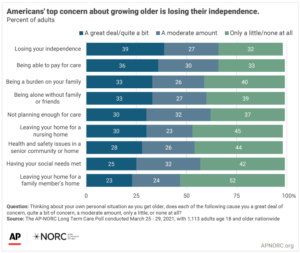In several recent blog posts, we discussed some of the common fears that people have around moving to a retirement community, including the fear of the unknown in senior living decisions. But at the root of many of these fears is the prevalent fear of losing independence as we grow older.
We frequently discuss the fact that a majority of today’s retirees say they want to remain in their home as they grow older. Furthermore, they say they want to remain independent for as long as possible. So, let’s consider what the concept of “losing independence” really means to older adults.
Americans’ preference for independence
The Associated Press (AP)-NORC Center for Public Affairs Research conducted a study in 2021 to look at some of the top reasons why people say that aging at home is their preference. The AP-NORC researchers used data collected through a monthly survey of a NORC panel selected to be representative of the U.S. household population of adults 18 and older.
The results, Long-Term Care in America: Americans Want to Age At Home (PDF), were based on this panel’s responses to long-term care-related questions including preferences on how and where they will receive any necessary care as they age. Among the key findings:
- 88% would like to receive any needed assistance or care in their own home or in a loved one’s home.
- Just 12% would prefer to receive care in a senior living community, such as an assisted living community or nursing home.
- 69% have done little or no planning or preparation to ensure their preference for aging at home is feasible.
- Just 16% are confident they will have the necessary financial resources to pay for long-term care, regardless of whether it is delivered at home or in a senior living community.
>> Related: Aging at Home or in a Senior Living Community: The Freedom of Choice
Losing independence is a top aging concern

Image credit: AP-NORC
There was another quite notable finding within the AP-NORC study. Respondents were asked about their top concerns about growing older.
- 36% said they were very concerned about the ability to pay for long-term care.
- 33% of survey respondents noted that they were very concerned about being a burden on their family as they age.
- 33% were extremely concerned about aging alone without family or friends.
But topping the list of respondents’ top concerns about growing older: For 66%, it is a fear of losing their independence, with 39% saying they have a great deal of concern about this issue, and 27% reporting a moderate amount of concern about this issue. Additionally, more than half (53%) of those surveyed also were worried about having to leave their home in order to move to a care facility.
>> Related: Independence: A Double-Edged Sword?
Defining “losing independence”
The findings of the AP-NORC research are eye-opening, but also reveal some deeper questions that need to be answered in order to better meet people’s senior living goals. In particular, when someone says they fear “losing independence,” what exactly do they mean by that — what is their definition of “losing independence”? And what is at the heart of their concern?
“Losing independence” is a somewhat vague concept that can mean different things to different people. For some, it may just mean avoiding being moved to an assisted living community or a nursing home. This is likely closely related to the AP-NORC finding that 88% of people would rather receive assistance or care in their own or a loved one’s own home.
For other people, their concerns about losing independence may be tied to worries about losing the ability to make their own decisions or maintain their own schedule. Humans crave autonomy; we generally don’t like being told what to do or when to do it. Some people may have the perception that living in a retirement community, particularly in a care setting, means being on a set schedule for things like meals, visitors, sleep, and recreation.
For still others, losing independence may mean losing the ability to safely stay in their own home. This may be the result of having a health issue (like a stroke or dementia), or it could just be the result of age-related decline, such as no longer being able to climb stairs.
>> Related: New Statistics Could Reshape the Meaning of Aging in Place
An ironic senior living concern
The irony of these examples of how older adults may define a loss of independence is that many of these scenarios are avoidable. The added irony is that many people who fear losing their independence may make decisions — consciously or unconsciously — that eventually lead to a very dependent situation.
For example, the AP-NORC study shows that most people want to remain in their home, receive any necessary care there, and/or worry about having to move to a care community. The result of these concerns is that people may not properly plan for the future’s what ifs.
A care need can arise slowly over a number of years or very suddenly, such as with an illness, an accident/injury, or an unplanned surgery. If a person lives in a home that is not conducive to home care (for instance, there are entryway stairs or there is no main floor bedroom and bathroom), or if they do not have access to paid or unpaid in-home caregivers, the person may have no choice but to relocate to a care facility — either temporarily or permanently, depending on the situation.
For those who noted a concern about losing the ability to make their own decisions or maintain their own schedule, here again, a lack of adequate planning for the future’s unknowns can come back to bite them.
As the AP-NORC study found, even among respondents aged 60 and older, fewer than half (46%) of people have discussed their long-term care preferences with their family and friends, and only 14% have shared their wishes with their doctors. As a result, should an unexpected care situation occur, their loved ones and care providers may be forced to make difficult decisions for them without knowing what the older adult would want.
>> Related: Have “The Talk” with Aging Parents Sooner Rather Than Later
Taking steps to avoid losing your independence
It is natural and common to worry about losing one’s independence as we grow older, as we see from the AP-NORC research. There are ways to help ensure you are able to maintain as much independence as possible, however. Most of the solutions revolve around keeping an open mind to your senior living options and doing proper planning.
For instance, the first and maybe simplest planning step to take is to ensure that your senior living and care goals are clear to your loved ones and physicians. This allows them to do their best to help you maintain your independence in a way that respects your preferences. Such planning includes being sure that your advance directives documents are up to date with your wishes.
Another proactive way to help you achieve your goal of maintaining independence is to both financially and logistically plan for any future care needs. This might include:
- Doing home upgrades to make your house more “aging friendly”
- Discussing with loved ones who would be willing and able to care for you should the need arise
- Looking at your savings to determine your ability to pay for in-home care
- Exploring if a long-term care insurance policy may be worth purchasing
- Developing a relationship with a local care manager or care coordination agency who already knows you if your needs should suddenly change later (care managers and coordinators do not provide care, they simply coordinate care and other services you may need.)
>> Related: For Senior Living Decisions, Are You a Planner, Procrastinator, or Crasher?
Considering your current living situation
Perhaps the most proactive step that people can take to ensure their independence, however, is to objectively look at their current home situation and determine if it can meet the older adult’s long-term needs. It can be difficult to remove all emotion from this analysis, but it is an important step for those who feel strongly about their ability to maintain their independence.
Looking at the home, are there few or no stairs to be negotiated should mobility decline, and is there a first-floor bedroom/bathroom? What about the width of the hallways and height of cabinets, which can be obstacles if you ever require the assistance of a wheelchair, for example. Will the location of the home allow access to transportation to shopping and healthcare if a person were no longer able to drive? Are there nearby friends/family members, as well as social and entertainment opportunities, to keep someone engaged and supported? These are just a few of the many considerations of staying in the home.
If an older adult can truthfully say that their current home checks all of the boxes, then they may in fact be able to remain in their home while maintaining their independence as they grow older (assuming they have access to paid or unpaid caregivers, if needed). However, if the home does not meet these criteria, a proactive move — either to a more suitable home or to a retirement community — may be the best way to meet your senior living goal of maintaining your independence.
>> Related: Aging in Place: 8 Questions to Consider
The retirement community option
Retirement communities, such as life plan communities (aks continuning care retirement communities or “CCRCs”) and other independent living 55-plus communities, are intended to help people stay as independent as possible for as long as possible. From their floor plans to their services and amenities (which can vary from one place to the next), these communities are specifically designed to keep residents healthy, safe, and happy.
But keep in mind that should your care needs progress to the point that they can no longer safely or effectively be provided in an independent living setting, a retirement community resident would need to move to a different community — either an assisted living community or a skilled nursing care facility. For people who wish to avoid multiple moves and/or want to ensure they will have ready access to any needed care services, a life plan community or CCRC may be a wise choice.
In addition to services and amenities that make life more convenient and worry-free, most CCRCs provide their residents with access to a full-continuum of care — from independent living to assisted living to full-time skilled nursing care. This gives residents tremendous peace of mind, knowing that should their care needs change — be it slowly or suddenly — they will get the level of care they need within that community.
>> Related: Comfort, Convenience, Connection: The Key Benefits of a Retirement Community
A proactive approach to avoid losing independence
For people who are worried that growing older means losing independence, a proactive approach to your senior living and any potential care needs can make all the difference. This includes doing your research and objectively analyzing your options — remaining in your current home, moving to a different home, or moving to a retirement community, including a CCRC — to decide the solution that helps you maintain your independence.

FREE Detailed Profile Reports on CCRCs/Life Plan Communities
Search Communities






